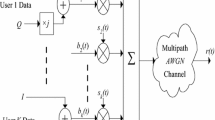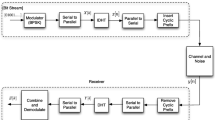Abstract
For the purpose of combating constant carrier envelope co-channel interference on a spread spectrum mobile link, a novelpolar adaptive A/D converter is analyzed and compared with the more familiar Cartesian form of the adaptive A/D. The polar A/D converter, operating in a noncoherent detection setting, is seen to exhibit fundamentally superior performance, even when the competing Cartesian converter is allowed to operate in a coherent detection mode. Very simple asymptotic performance formulas are given for both the polar and Cartesian forms.
Similar content being viewed by others
Explore related subjects
Discover the latest articles, news and stories from top researchers in related subjects.References
L.B. Milstein, Interference rejection techniques in spread spectrum communications, Proc. IEEE 76(1988)657–671.
G.L. Turin, An introduction to digital matched filters, Proc. IEEE 64(1976)1092–1112.
T.L. Lim, Non-coherent digital matched filters: multibit quantization, IEEE Trans. Commun. COM-26(1978)409–419.
F. Amoroso, Adaptive A/D converter to suppress CW interference in spread spectrum communications, IEEE Trans. Commun. COM-31(1983)1117–1123.
K.V. Cai, Optimization of 2-bit A/D adaptive converter performance in CW interference,IEEE MILCOM'84, Paper No. 39.3, Los Angeles, CA (1984).
J.L. Bricker, Mathematical methodology for analysis of the adaptive A/D converter in combined CW and Gaussian interference,IEEE MILCOM'84, Paper No. 39.2, Los Angeles, CA (1984).
F. Amoroso and J.L. Bricker, Performance of the adaptive A/D converter in combined CW and Gaussian interference, IEEE Trans. on Commun. COM-34(1986)209–213.
F.J. Pergal, Adaptive threshold A/D conversion techniques for interference rejection in DSPN receiver applications,1987 IEEE Military Communications Conference, Paper No. 4.7, Washington, DC (1987).
A. Gosier and M. Sust, Adaptive interference rejection in a digital direct sequence spread spectrum receiver,1989 IEEE Military Communications Conference (MILCOM'89), Paper No. 28.6, Boston, MA (1989).
F. Amoroso and J.L. Bricker, U.S. Patent No. 5,016,261, Method and apparatus for achieving improved anti-jam performancee via conversion gain (1991).
F. Amoroso and J.L. Bricker, Increasing the uplink CW interference immunity of noncoherent direct sequence pseudonoise (DSPN) reception with on-board processing, Int. J. Satellite Commun. 11(3)(1993)107–118.
J.J. Spilker,Digital Communications by Satellite (Prentice-Hall, Englewood Cliffs, 1977) section 9-5.
P.W. Baier and K.-J. Friederichs, A nonlinear device to suppress strong interfering signals with arbitrary angle modulation in spread-spectrum receivers, IEEE Trans. Commun. COM-3(1985)300–302.
G.C. Bagley, Digital processing of signal phase angle, IEEE Trans. Aerospace and Electronic Syst. AES-9(1973)953–954.
Author information
Authors and Affiliations
Rights and permissions
About this article
Cite this article
Amoroso, F. Adaptive A/D converter to suppress co-channel constant envelope interference in a mobile digital link. Telecommunication Systems 2, 109–119 (1993). https://doi.org/10.1007/BF02109852
Received:
Revised:
Issue Date:
DOI: https://doi.org/10.1007/BF02109852




